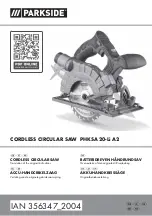
38
As with all types of cutting large work pieces can be ac-
commodated for, using the sliding action of the saw.
CUTTING WARPED MATERIAL
When cutting warped material always make sure it is posi-
tioned on the mitre table with the bow facing outmost see
fingures below.
3
5
When cutting the wood or moulding support the overhang-
ing ends with the material supports supplied. Allow the
blade the reach maximum speed before commencing the
cut. As always never force the cutting blade through the
work.
COMPOUND MITRE CUTTING
A compound mitre cut is made using a mitre angle and a
bevel angle at the same time.
To make this cut the mitre table must be rotated to the cor-
rect angle and the saw arm tilted to the correct angle.
Because of the complexity of the compound mitre cut it
may be desirable to make a number of trial cuts with scrap
material before attempting to cut the final work piece. Re-
member the mitre and bevel angles are independent to each
other. So each time you alter one angle the other should be
checked.
To compound mitre cut
Pull out the lock pin and lift the saw arm to its upper posi-
tion. Loosen the mitre table lock knob and rotate the table
to the desired angle. Retighten the mitre table lock knob
(see crosscutting section of this manual).
Loosen the bevel lock lever and move the saw arm to the
desired angle. (see bevel cutting section of this manual).
Securely lock the bevel lock lever.
As with all cuts secure the work piece on to the mitre table
against the fence and secure with the vice clamps. Perform
the cut as described in the crosscutting section of this ma-
nual.
















































